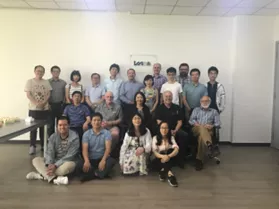Dr Árpád Kis, senior researcher of the ELKH Research Institute of Earth Physics and Space Science (FI) and deputy director responsible for the development of space research, and Dr Gábor Facskó, senior researcher of the Department of Space Physics and Space Technology of the ELKH Wigner Research Centre for Physics (Wigner RPC), have participated in an international research group's work that has been investigating the explosive phenomena lasting just a few minutes that have been observed on the side of the Earth's magnetosphere facing the Sun. The latest research findings published in the journal Space Science Reviews on June 28, 2022 are a significant contribution to a more accurate knowledge and understanding of the phenomena of space weather. The research group was awarded a grant from the International Space Science Institute (ISSI) in 2017.
The study "Dayside Transient Phenomena and Their Impact on the Magnetosphere and Ionosphere" is the result of many years of work and was completed through close cooperation between American, Japanese, Chinese, Finnish, French, Norwegian and Hungarian researchers. The authors provide the most complete and most comprehensive, up-to-date summary of the topic in this article. As part of the research, satellite measurements and numerical plasma simulations were used to investigate the explosive phenomena lasting a few minutes that have been observed on the sunward side of the Earth's magnetosphere. These are created by the solar wind-magnetosphere interaction before and behind the shock wave in front of the Earth, in the magnetic envelope. The researchers also studied the global effects of these processes in the magnetosphere, ionosphere and polar region.

Members of the research group. Back row, standing (from left to right): Xuzhi Zhou, Quanqi Shi, Yu Lin, De-Sheng Han, Hiroshi Hasegawa, Árpád Kis, Hui Zhang, Kjellmar Oksavik, Mengmeng Wang, Gábor Facskó, Liangliang Zhao and Jinyan Zhao. Second row, seated: Quigang Zong, Antonius Otto, Guan Le, David Sibeck and Bertrand Lembège. First row, sitting on the floor: Shuai Zhang, Yong Liu, Ji Liu and Shichen Bai.
(Source: https://daysidetransientphenomena.wordpress.com/).
ISSI, based in Bern, is one of the world's most important institutes dealing with space science. In cooperation with its partner institution, ISSI-BJ, based in Beijing, ISSI supports the creation of topic-oriented international research groups that, once selected, work together for a period of years on the designated research topic. Only internationally known and recognized researchers can join the ISSI research groups, which means that participation in itself is an outstanding recognition. In light of this, it is particularly noteworthy that two Hungarian researchers participated in the work of the research group selected for support by ISSI in 2017.

Schematic view of the structure and location of the head wave and the associated outer plasma regions representing the outer boundary of the Earth's magnetosphere. This area is the site of many interesting and complex physical processes. (Source: Tsurutani & Rodriguez 1981; Hui Zhang et al. 2022)
Space Science Reviews belongs to the Springer Nature group and is one of the most important journals in the field of space science. The importance of the summary article prepared with the participation of Hungarian researchers is clearly demonstrated by the fact that it will also soon be published in hardcover form as an independent specialist book. Many other technical articles of the research group have also been published during the years of cooperation.
Publication:
Hui Zhang, Qiugang Zong, Hyunju Connor, Peter Delamere, Gábor Facskó, Desheng Han, Hiroshi Hasegawa, Esa Kallio, Árpád Kis, Guan Le, Bertrand Lembège, Yu Lin, Terry Liu, Kjellmar Oksavik, Nojan Omidi, Antonius Otto, Jie Ren, Quanqi Shi, David Sibeck, Shutao Yao, Dayside transient phenomena and their impact on the magnetosphere and ionosphere, Space Science Reviews, 218, 40 (2022).